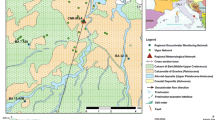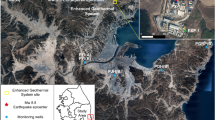Abstract
This study was performed to examine the chemical and isotopic compositions of groundwater used in open loop GHP systems and natural groundwater around the open loop GHP systems and to evaluate the influence of open loop GHP systems’ operation on groundwater chemistry in Korea. The water temperature of groundwater used in open loop GHP systems ranged from 6.0 to 37.1°C and decreased by 6.7 to 11.6°C compared with that of natural groundwater around the open loop GHP systems. The pH, EC, Eh, Fe2+, and Mn2+ of the groundwater were not significantly affected by open loop GHP systems’ operation. The groundwaters used in open loop GHP systems showed various water types, such as Ca-HCO3, Ca-Cl, Ca-SO4, and Na-HCO3· Although HCO3 - and Cl- concentrations were slightly influenced by open loop GHP systems at some sites, the groundwater chemistry used in the open loop GHP systems did not significantly change at most sites. In addition, carbonate and silica minerals and minerals containing Mn were in undersaturated condition, which indicates that the precipitation of these minerals will not occur. However, some minerals containing Fe, such as Fe(OH)3, goethite, and hematite can be precipitated as scale within these system. In the open loop GHP systems selected in this study, the influence of open loop GHP systems on groundwater chemistry is not revealed sufficiently because of short-term monitoring of groundwater chemistry. However, integrated long-term monitoring is necessary to evaluate influence of open loop GHP systems on groundwater chemistry and to improve our understanding of the environmental impacts related to these systems.
Similar content being viewed by others
References
Abesser, C., 2010, Open-loop ground source heat pumps and the groundwater systems: A literature review of current application, regulations and problems. Energy Geoscience Programme Open Report OR/10/045, British Geological Survey, Nottingham, 24 p.
Allison, J.D., Brown, D.S., and Novo-Gradac, K.J., 1991, MINTEQA2. A geochemical assessment data base and test cases for environmental system: Verse. 3.0 user’s manual. United States Environmental Protection Agency, Athens, 77 p.
Banks, D., 2009, Thermogeological assessment of open-loop welldoublet schemes: a review and synthesis of analytical approaches. Hydrogeology Journal, 17, 1149–1155.
Bonte, M., 2013, Impacts of shallow geothermal energy on groundwater quality-a hydrochemical and geomicrobial study on the effects of ground source heat pumps and aquifer thermal energy storage. Ph.D. thesis, VU University Amsterdam, Amsterdam, 175 p.
Bouwer, H., 2002, Artificial recharge of groundwater: hydrogeology and engineering. Hydrogeology Journal, 10, 121–142.
Brons, H.J., Griffioen, J., Appelo, C.A.J., and Zehnder, A.J.B., 1991, (Bio)geochemical reactions in aquifer material from a thermal energy storage site. Water Research, 25, 729–736.
CACC (Carrier Air Conditioning Company), 1965, Handbook of air conditioning system design. McGraw-Hill book company, New York, 780 p.
Clark, I.D. and Fritz, P., 1997, Environmental isotopes in hydrology. Lewis Publishers, New York, 328 p.
Curtis, R., Lund, J., Sanner, B., Rybach, L., and Hellström, G., 2005, Ground source heat pumps — Geothermal energy for anyone, anywhere: current worldwide activity. Proceedings World Geothermal Congress 2005, Antalya, Apr. 24–29, 1–9.
EA (Environmental Agency), 2011, Environmental good practice guide for ground source heating and cooling. Report GEHO0311BTPA-EE, Environmental Agency of England and Wales, Bristol, 34 p.
Ferguson, G. and Woodbury, A.D., 2004, Subsurface heat flow in an urban environment. Journal of Geophysical Research, 109, DOI:10.1029/2003JB002715.
Gao, Q., Li, M., Yu, M., Spitler, J.D., and Yan, Y.Y., 2009, Review of development from GSHP to UTES in China and other countries. Renewable and Sustainable Energy Reviews, 13, 1383–1394.
Garrels R.M. and Christ, C.I., 1965, Solutions, minerals, and equilibria. Harper & Row, New York, 450 p.
Grassian, V.H., 2005, Environmental catalysis. Taylor & Francis, Kentucky, 701 p.
Griffioen, J. and Appelo, C.A.J., 1993, Nature and extent of carbonate precipitation during aquifer thermal energy storage. Applied Geochemistry, 8, 161–176.
Gropius, M., 2010, Numerical groundwater flow and heat transport modelling of open-loop ground source heat systems in the London Chalk. Quarterly Journal of Engineering Geology and Hydrogeology, 43, 23–32.
Guimerá, J., Ortuño, F., Ruiz, E., Delos, A., and Pérez-Paricio, A., 2007, Influence of ground-source heat pump on groundwater. Proceedings World Geothermal Congress 2007, Unterhaching, May 30–Jun. 1, 1–8.
Holm, T.R., Eisenreich, S.J., Rosenberg, H.L., and Holm, N.P., 1987, Groundwater geochemistry of short-term aquifer thermal energy storage test cycles. Water Resources Research, 23, 1005–1019.
Hoyer, M., Hallgren, J., Eisenreich, S., and Sterling, R., 1994. Fieldtest results of Aquifer Thermal Energy Storage at St. Paul, Minnesota. Journal of Energy Engineering, 120, 67–85.
Hyun, S.G., Woo, N.C., Shin, W.S., and Hamm, S.Y., 2006, Characteristic of groundwater quality in a riverbank filtration area. Economic and Environmental Geology, 39, 151–162. (in Korean with English abstract)
Kelly, T., 2009, Management of the London basin chalk aquifer. Status Report 2009, Environment Agency of England and Wales, Bristol, 53 p.
Kwon, K.S., Lee, J.Y., and Mok, J.K., 2012, Update of current status on ground source heat pumps in Korea. Journal of the Geological Society of Korea, 48, 193–199. (in Korean)
Lee, J.Y., 2009, Current status of ground source heat pumps in Korea. Renewable and Sustainable Energy Reviews, 13, 1560–1568.
Lee, K.S. and Chung, J.I., 1997, Stable isotopic variation of precipitation in Pohang, Korea. Economic and Environmental Geology, 30, 321–325.
Lee, K.S. and Lee, C.B., 1999, Oxygen and hydrogen isotopic composition of precipitation and river water in South Korea. Journal of the Geology Society of Korea, 35, 73–84. (in Korean with English abstract)
Lund, J.W. and Bertani, R., 2010, Worldwide geothermal utilization 2010. Geothermal Resources Council Annual Meeting 2010, Sacramento, Oct. 24–27, p. 182–185.
Lund, J., Sanner, B., Rybach, L., Curtis, R., and Hellström, G., 2004, Geothermal (ground-source) heat pumps a world overview. Geo-Heat Center Bulletin, 25, 1–10.
Park, Y., Kwon, K.S., Kim, N., Lee, J.Y., and Yoon, J.G., 2013a, Change of geochemical properties of groundwater by use of open loop geothermal cooling and heating system. Journal of the Geological Society of Korea, 49, 289–296. (in Korean with English abstract)
Park, Y., Mok, J.K., Jang, B.J., Park, Y.C., and Lee, J.Y., 2013b, Influence of open and closed loop geothermal cooling and heating systems on hydrogeological properties. Journal of the Geological Society of Korea, 49, 649–659. (in Korean with English abstract)
Parkhurst, D.L. and Appelo, C.A.J., 1999, User’s guide to PHREEQC (version 2) — a computer program for speciation, batch-reaction, one-dimensional transport, and inverse geochemical calculations. United State Geological Survey, Denver, 312 p.
Possemiers, M., Huysmans, M., and Batelaan, O., 2014, Influence of aquifer thermal energy storage on groundwater quality: A review illustrated by seven case studies from Belgium. Journal of Hydrology: Regional Studies, 2, 20–34.
Rafferty, K., 1999, Scaling in geothermal heat pump system. United States Department of Energy, Washington DC, 60 p.
Rafferty, K., 2003, Ground water issues in geothermal heat pump systems. Ground Water, 41, 408–410.
Rafferty, K., 2004, Water chemistry issues in geothermal heat pump systems. ASHRAE Transactions, 110, 550–555.
Sanner, B., Karytsas, C., Mendrinos, D., and Rybach, L., 2003, Current status of ground source heat pumps and underground thermal energy storage in Europe. Geothermics, 32, 579–588.
Self, S.J., Reddy, B.V., and Rosen, M. A., 2013, Geothermal heat pump systems: Status review and comparison with other heating options. Applied Energy, 101, 341–348.
Simpson, T., Blower, R.N., Craig, R.N., and Wilkinson, W.B., 1989, The engineering implications of rising groundwater levels in the deep aquifer beneath London. Construction Industry Research & Information Association, London, 116 p.
Sowers, L., York, K.P., and Stiles, L., 2006, Impact of thermal buildup on groundwater chemistry and aquifer microbes. Proceedings of Ecostock 2006, Pomona, May 31–June 2, p. 1–7.
Stumm, W. and Morgan, J.J., 1996, Aquatic chemistry: chemical equilibria and rates in natural waters third edition. John Wiley & Sons, New York, 1022 p.
USEPA (United States Environmental Protection Agency), 1997, Manual on environmental issues related to geothermal heat pump systems. EPA 430-B-97-028, United States Environmental Protection Agency, Washington DC, 98 p.
USEPA (United States Environmental Protection Agency), 1999, The class V underground injection study: Volume 19: Heat pump and air conditioning return flow wells. EPA 816-R-99-014s, United States Environmental Protection Agency, Washington DC, 60 p.
Zhu, K., Blum, P., Ferguson, G., Balke, K.D., and Bayer, P., 2011, The geothermal potential of urban heat islands. Environmental Research Letters, 5, 6.
Zia, K.M., Bhatti, H.N., Bhatti, I.A., and Nawaz, R., 2008, A pHs equation for calcium carbonate scale prediction in cooling water systems. Journal of Chemical Society of Pakistan, 30, 182–185.
Author information
Authors and Affiliations
Corresponding author
Rights and permissions
About this article
Cite this article
Park, Y., Kim, N. & Lee, JY. Geochemical properties of groundwater affected by open loop geothermal heat pump systems in Korea. Geosci J 19, 515–526 (2015). https://doi.org/10.1007/s12303-014-0059-x
Received:
Accepted:
Published:
Issue Date:
DOI: https://doi.org/10.1007/s12303-014-0059-x




